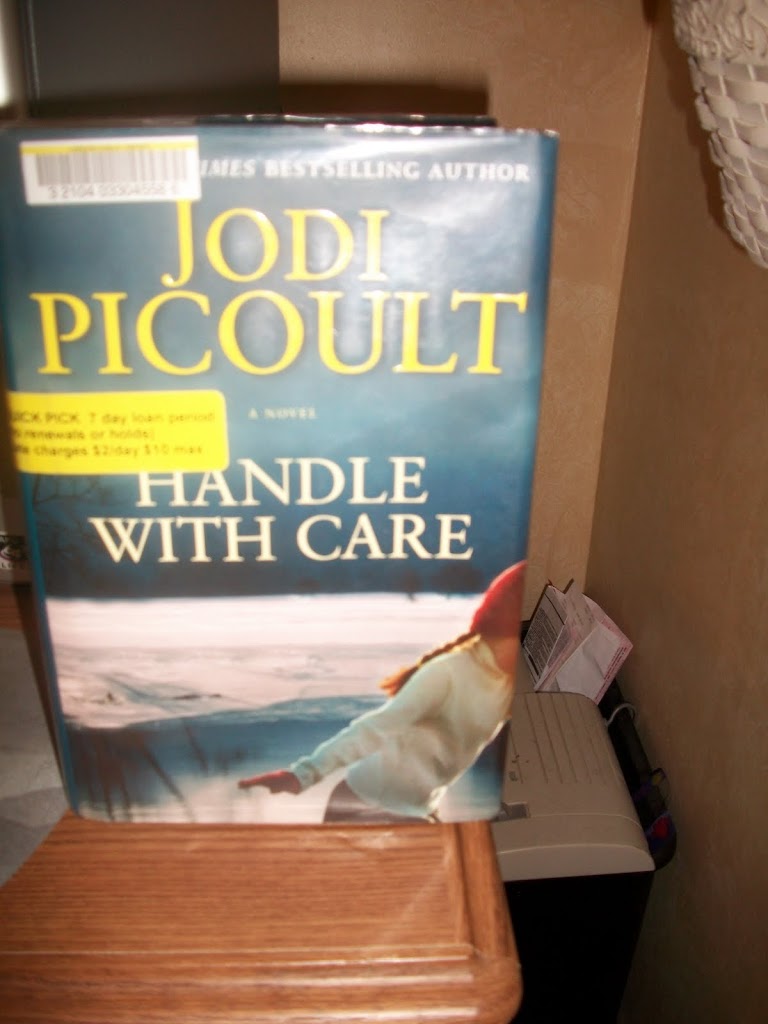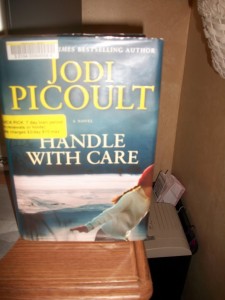
Handle With Care by Jodi Picoult
Anyone who knows me really well knows that I adore Jodi Picoult and am rapidly working my way through everything she’s ever published. Today I finished reading Handle With Care, a truly beautiful poignant story about a family pushed to the brink of breaking by a daughter, Willow’s disability and a lawsuit that the family initiates. Willow has osteogenesis imperfecta and the fact that I can spell that by memory now is one of the many reasons I adore this author. So this is to be a strange list hyphen book review of the many reasons why this author is inspirational to me.
And by the way this book also gets a solid thriftymommastips rating of at least $$$$ 1/2 out of $$$$$.
1. Jodi Picoult novels are always meticulously researched and topical. Nothing I hate more than reading a great story only to be jarred by something that doesn’t ring true. Rarely has this happened to me with Picoult.
2. The themes of loss, grief and adoption are so skillfully rendered that I cannot get enough. In this novel Handle With Care, one of the main characters, Marin, a lawyer, is seeking further information and a reunion with her birth mother, that eventually disappoints. I love that this is so thoroughly real and not sweet made up fairytale ending stuff. Marin eventually discovers her birthmother is someone she knows and, full of so much hope and the expectation of a relationship she discovers she has two part siblings. “There are some babies who are better off not being born,” says the birthmother when they finally meet. She advises Marin not to contact her again. “And just like that, my birth mother abandoned me for the second time in my life.”
3. Picoult is a former journalist so she gets points for transitioning to novelist.
4. She has a remarkable way of weaving subplots and underlying motifs throughout that create lovely metaphors for all her stories. Love that! In this one Charlotte, Willow’s mother, is a former pastry chef and so recipes are woven throughout. Mostly fragile difficult concoctions that underscore the fragility of the main characters.
5.There is seldom a black and white portrait of anyone here, just shades of grey. In Picoult novel’s siblings of children with special needs like Amelia hide their own needs/dysfunction. Similarily all characters are not always as they seem and mothers act humanely and poorly by turns never idealized, only three dimensional.
6. There are often small devices such as newspaper articles, recipes, reviews, drawing, reports etcetera thrown into the book to further the plot and break it up slightly. Picoult is one of the only novelists I have ever read for whom these newspaper articles ring true. They could have been published.
7. There is always, towards the end a twist, a part so gripping that you know will rip your heart out and kick you in the gut. With Picoult you can expect the unexpected.
8. Domestic themes are larger than life. Picoult, a mother of three, can see the extraordinary inside what to many might seem small and trivial.
9. I always learn something from reading these fictional stories, even if it is so simple as Willow’s trivia. For instance a shrimp can swim backwards. This writing inspires me to be a better writer. It’s that good.
10. Her novels always start poetically and draw you in quick like a good newspaper or magazine feature. This one begins: “Things break all the time. Glasses, and dishes and fingernails. Cars and contracts and potato chips.. .” While I have seen this start previously almost indentically done in Nineteen Minutes, it still draws me in without revealing too much of the story. Gorgeous, if a little bit by this particular author.
11. Stories are often told from multiple viewpoints, narrators. This is very tricky to do as a writer.
12. Sentence fragments. Need I say more. Picoult knows there can be more power in a sentence done creatively with fragments than one done technically – subject verb adverb.
Now what are you waiting for go get the book.
Hardcover Simon and Schuster, $34.99 in Canada, 2009




